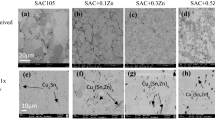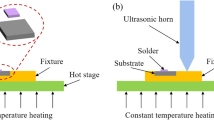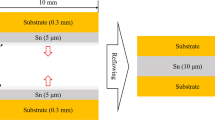Abstract
This study examines factor(s) behind the formation of primary Cu6Sn5 (in the bulk, rather than at the interface) in solder joints, even though solder alloys are hypoeutectic. To understand the contribution from copper (Cu) dissolution from the substrate a Cu-free alloy, tin-3.5 silver (Sn-3.5Ag), was used as a soldered-on copper organic solderability preservative (Cu-OSP) and electroless nickel immersion gold (ENIG) surface finish substrates. Microstructure observations including in situ synchrotron were used to observe microstructure development real-time and confirm the time and location for nucleation of primary Cu6Sn5. High-speed shear tests were performed to determine the solder joint’s strengths. The results confirm that Cu dissolution during soldering is responsible for the formation of primary Cu6Sn5. The ENIG finish prevented Cu dissolution and the formation of Cu6Sn5 resulting in higher solder joint strength for the Sn-3.5Ag/ENIG solder joints. The findings can be used to understand the evolution of primary Cu6Sn5 and how it can be suppressed to improve joint strength.
Similar content being viewed by others
References
J.W. Yoon, B.I. Noh, and S.B. Jung, J. Alloys Compd. 506, 331 (2010).
Z. Huang, P. Kumar, I. Dutta, R. Sidhu, M. Renavikar, and R. Mahajan, J. Electron. Mater. 43, 4485 (2014).
J.M. Kim, M.H. Jeong, S. Yoo, and Y.B. Park, J. Electron. Mater. 41, 791 (2012).
T.H. Chuang, C.C. Jain, and S.S. Wang, J. Mater. Eng. Perform. 18, 1133 (2009).
Y. Tian, W. Liu, R. An, W. Zhang, L. Niu, and C. Wang, J. Mater. Sci.-Mater. Electron. 23, 136 (2012).
G. Zeng, S. Xue, L. Zhang, L. Gao, W. Dai, and J. Luo, J. Mater. Sci-Mater. Electron. 21, 421 (2010).
J.M. Kim, M.H. Jeong, S. Yoo, C.W. Lee, and Y.B. Park, Microelectron. Eng. 89, 55 (2012).
J.W. Xian, S.A. Belyakov, M. Ollivier, K. Nogita, H. Yasuda, and C.M. Gourlay, Acta Mater. 126, 540 (2017).
J.W. Xian, S.A. Belyakov, and C.M. Gourlay, J. Electron. Mater. 45, 69 (2016).
M.A.A. Mohd Salleh, S.D. McDonald, C.M. Gourlay, S.A. Belyakov, H. Yasuda, and K. Nogita, J. Electron. Mater. 45, 154 (2016).
M.A.A. Mohd Salleh, C.M. Gourlay, J.W. Xian, S.A. Belyakov, H. Yasuda, S.D. McDonald, and K. Nogita, Sci. Rep.-UK 7, 1 (2017).
J. Shen, Y.C. Chan, and S.Y. Liu, Acta Mater. 57, 5196 (2009).
Z. Chen, A. Kumar, and M. Mona, J. Electron. Mater. 35, 2126 (2006).
M.A.A. Mohd Salleh, S.D. McDonald, H. Yasuda, A. Sugiyama, and K. Nogita, Scr. Mater. 100, 17 (2015).
P.F. Yang, Y.S. Lai, S.R. Jian, J. Chen, and R.S. Chen, Mater. Sci. Eng. A 485, 305 (2008).
S.K. Kang, W.K. Choi, D.Y. Shih, D.W. Henderson, T. Gosselin, A. Sarkhel, C. Goldsmith, and K.J. Puttlitz, JOM 55, 61 (2003).
T. Garami and O. Krammer, J. Mater. Sci.-Mater. Electron. 26, 8540 (2015).
H. Esaka, K. Shinozuka, and M. Tamura, Mater. Trans. (2005). https://doi.org/10.2320/matertrans.46.916.
Y. Takamatsu, H. Esaka, and K. Shinozuka, Mater. Trans. (2011). https://doi.org/10.2320/matertrans.M2010325.
J.W. Kim, Y.C. Lee, S.S. Ha, and S.B. Jung, J. Mater. Sci.-Mater. Electron. 20, 17 (2009).
H. Tskukamoto, T. Nishimura, S. Suenaga, and K. Nogita, Mater. Sci. Eng. B 171, 162 (2010).
H. Tskukamoto, T. Nishimura, S. Suenaga, S.D. McDonald, K.W. Sweatman, and K. Nogita, Microelectron. Reliab. 51, 657 (2011).
A. Kumar, Z. Chen, S.G. Mhaisalkar, C.C. Wong, P.S. Teo, and V. Kripesh, Thin Solid Films 504, 410 (2006).
Acknowledgments
The authors gratefully acknowledge the financial support from the Universiti Malaysia Perlis (UniMAP), Nihon Superior Co. Ltd. collaboration research project and the fundamental research grant scheme (FRGS) FRGS/1/2017/TK05/UNIMAP/03/3 (9003-00621) from the Ministry of Higher Education, Malaysia. Authors would like to thank N.R. Abdul Razak at the University of Queensland and UniMAP for the help in preparing the samples and helping in synchrotron imaging experiments. Real-time in situ synchrotron imaging experiments were performed at the Japan Synchrotron Radiation Research Institute (JASRI) using BL20XU beamline of the SPring-8 Synchrotron (2017B1519 and 2019B1618) which is also supported by Grant-in-Aid for Scientific Research (S) (No. 17H06155), JSPS, Japan. The micro-XRF mapping technique was performed at the Synchrotron Light Research Institute (SLRI), Thailand (Project ID: 6031). The high-speed shear test was conducted at Nihon Superior R&D Center, Osaka, Japan.
Author information
Authors and Affiliations
Corresponding author
Ethics declarations
Conflict of interest
The authors declare that they have no conflict of interest.
Additional information
Publisher's Note
Springer Nature remains neutral with regard to jurisdictional claims in published maps and institutional affiliations.
Rights and permissions
About this article
Cite this article
Muhd Amli, S.F.N., Mohd Salleh, M.A.A., Ramli, M.I.I. et al. Origin of Primary Cu6Sn5 in Hypoeutectic Solder Alloys and a Method of Suppression to Improve Mechanical Properties. J. Electron. Mater. 50, 710–722 (2021). https://doi.org/10.1007/s11664-020-08428-9
Received:
Accepted:
Published:
Issue Date:
DOI: https://doi.org/10.1007/s11664-020-08428-9




